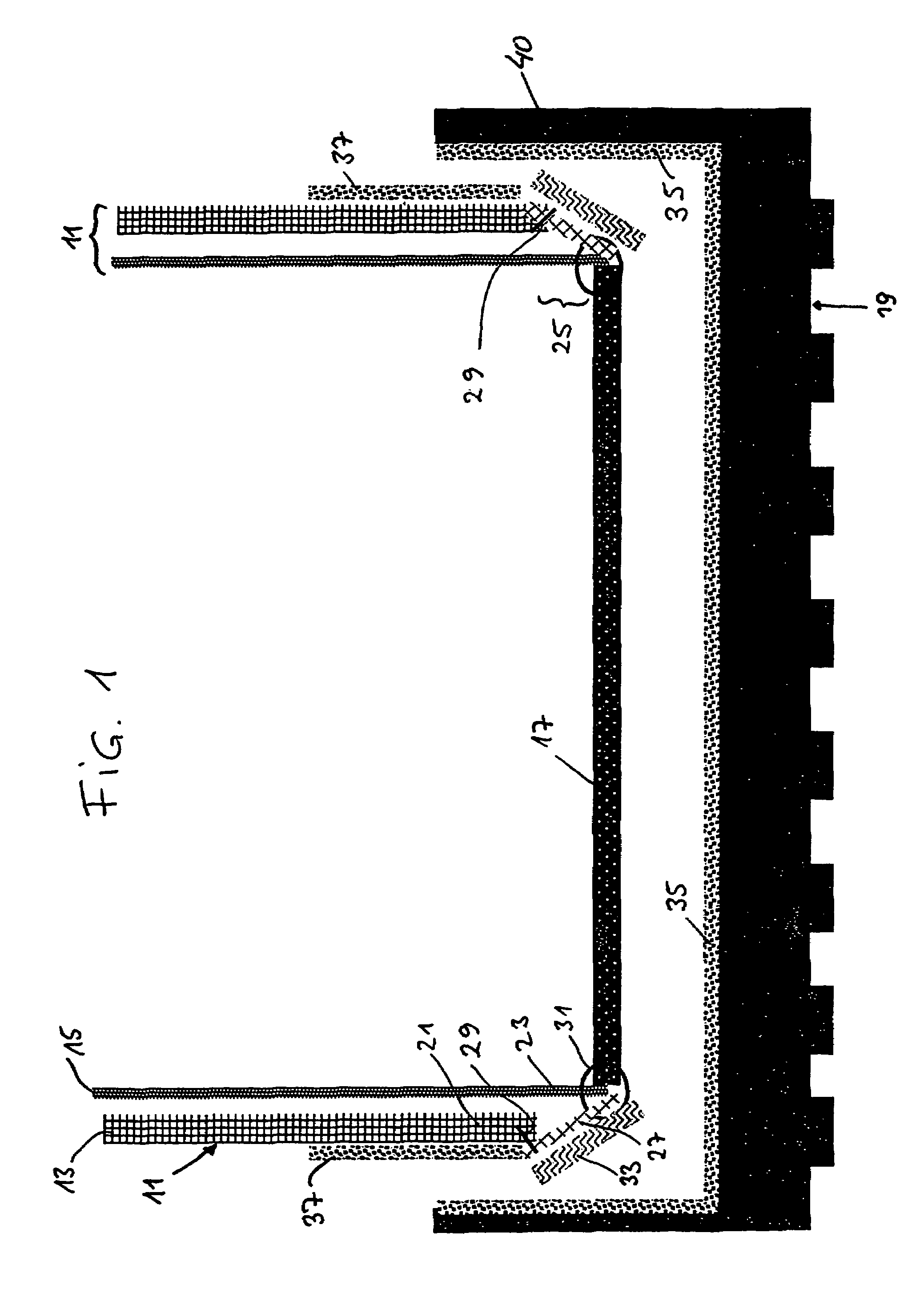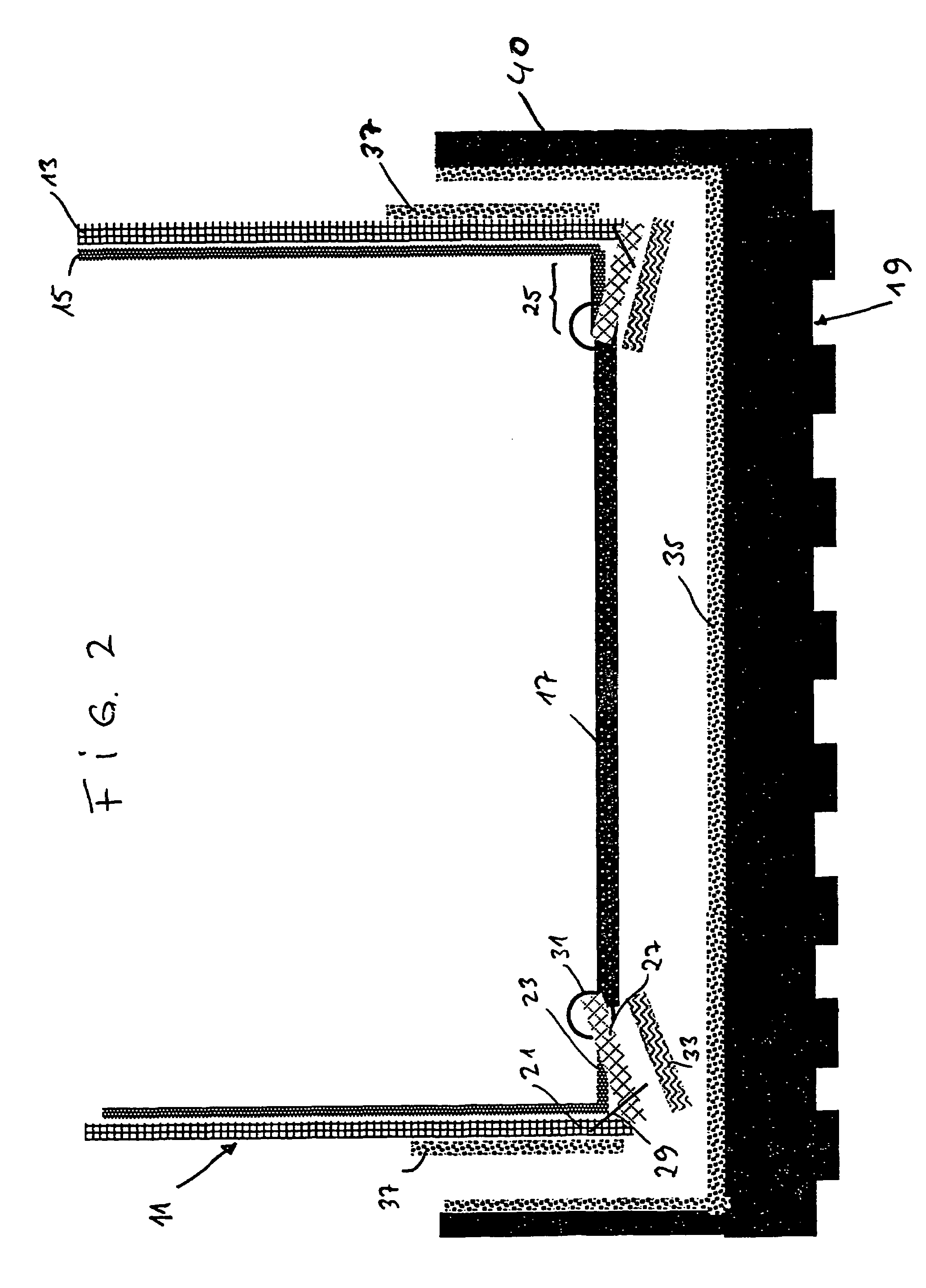Footwear with sealed sole construction and method for producing same
- Summary
- Abstract
- Description
- Claims
- Application Information
AI Technical Summary
Benefits of technology
Problems solved by technology
Method used
Image
Examples
first embodiment
[0081]FIG. 1 shows in a highly schematized cross-sectional representation a shoe according to the invention, with an upper 11, which is constructed with an outer material 13 and a functional layer 15 lining the inner side of the latter. The functional layer 15 may be part of a functional-layer laminate, which has the functional layer and a lining layer on the inner side of the latter. Furthermore, the functional layer 15 may be provided with a textile backing (not represented) on its outer side facing the outer material 13. There are also embodiments in which the functional layer and the lining are separate layers of material.
[0082]Furthermore, FIG. 1 shows an insole 17 and a dish-like, prefabricated outsole 19, which is constructed with rubber and / or plastic. The outer material 13 and the functional layer 15 have an outer-material end region 21 or functional-layer end region 23 ending vertically, i.e. perpendicular to the tread of the outsole 19. The functional-layer end region 23 ...
third embodiment
[0089]The third embodiment, shown in FIG. 3, is shown in FIG. 4 in a partially sectioned perspective representation, but still without an outsole. This figure shows a last 41, over which the upper 11 has been pulled. As a departure from FIG. 3, in FIG. 4 a separate lining layer 43 is shown on the inner side of the functional layer 15. FIG. 4 shows the shoe construction in a state in which the reactive hot-melt adhesive has been applied only to the underside of the gauze strip 27, but has not yet been pushed through the gauze strip 27 to penetrate as far as the functional-layer end region 23.
[0090]FIG. 5 shows a shoe construction according to FIG. 4, likewise in a partially sectioned perspective representation, after the adhesive attachment of an outsole 39 to the underside of the insole 17 and to the underside of the vertical region of the upper 11. In this representation, the last 41 has already been removed from the shoe.
[0091]For better illustration, a circular detail of the sole...
fourth embodiment
[0094]In the fourth embodiment there is no connection between the lower end of the outer-material end region 21 and the lower end of the functional-layer end region 23 and the insole 17 before the adhesive attachment of the outsole 19 and before adhesive bonding with the reactive hot-melt adhesive 33 in the upper end region. Only after application of the reactive hot-melt adhesive 33 is there a connection between the outer-material end region 21 and the functional-layer end region 23 on account of the adhesive effect of the said adhesive, if the reactive hot-melt adhesive is applied to such an extent that it includes the lower edge of the outer-material end region, which is not absolutely necessary. After the adhesive attachment of the outsole 19 to the insole 17 and the upper 11, the outer-material end region 21 is also laterally fixed by means of the upturned edge 40 of the outsole 19.
[0095]The fifth embodiment, shown in FIG. 8, coincides with the fourth embodiment, shown in FIG. ...
PUM
 Login to View More
Login to View More Abstract
Description
Claims
Application Information
 Login to View More
Login to View More - R&D
- Intellectual Property
- Life Sciences
- Materials
- Tech Scout
- Unparalleled Data Quality
- Higher Quality Content
- 60% Fewer Hallucinations
Browse by: Latest US Patents, China's latest patents, Technical Efficacy Thesaurus, Application Domain, Technology Topic, Popular Technical Reports.
© 2025 PatSnap. All rights reserved.Legal|Privacy policy|Modern Slavery Act Transparency Statement|Sitemap|About US| Contact US: help@patsnap.com



